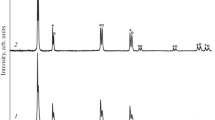Abstract
The electrochemical behavior of a porous electrode based on Pr2CuO4 (PCO) screen printed on the surface of Ce0.9Gd0.1O1.95 (CGO) solid electrolyte is studied by impedance spectroscopy. The rate-determining stages of the oxygen reduction reaction at the PCO/CGO interface are found for the oxygen partial pressure interval of 30–105 Pa and temperatures of 773–1173 K. Changeover of the rate-determining stage of electrode reaction is shown to occur depending on the temperature and the oxygen partial pressure. The PCO electrode polarization resistance is 1.7 Ω cm2 at 973 K in air and remains constant at thermocycling of the electrochemical cell in the temperature range of 773–1173 K. Based on the found data, PCO can be considered as the promising cathodic material for solid-oxide fuel cells operating at moderate temperatures (773–973 K).
Similar content being viewed by others
References
Steele, B.C.H. and Heinzel, A., Nature, 2001, vol. 414, p. 345.
Jacobson, A.J., Chem. Mater., 2010, vol. 22, p. 660.
Orera, A. and Slater, P.R., Chem. Mater., 2010, vol. 22, p. 675.
Aguadero, A., Fawcett, L., Taub, S., Woolley, R., Wu, K.T., Xu, N., Kilner, J.A., and Skinner, S.J., J. Mater. Sci., 2012, vol. 47, p. 3925.
Mazo, G.N., Kaluzhskikh, M.S., Savvin, S.N., Leonova, L.S., Lyskov, N.V., and Dobrovol’skii, Yu.A., Russ. J. Electrochem., 2009, vol. 45, p. 450.
Soorie, M. and Skinner, S.J., Solid State Ionics, 2006, vol. 177, p. 2081.
Li, Q., Zhao, H., Huo, L., Sun, L., Cheng, X., and Grenier, J.C., Electrochem. Commun., 2007, vol. 9, p. 1508.
Lyskov, N.V., Leonova, L.S., and Mazo, G.N., Russ. J. Electrochem., 2011, vol. 47, p. 586.
Li, Q., Zeng, X., Sun, L., Zhao, H., Huo, L., and Grenier, J.C., Int. J. Hydrogen Energy, 2012, vol. 37, p. 2552.
George, A.M., Gopalakrishnan, I.K., and Karkhanavala, M.D., Mater. Res. Bull., 1974, vol. 9, p. 721.
Kaluzhskikh, M.S., Kazakov, S.M., Mazo, G.N., Istomin, S.Ya., Antipov, E.V., Gippius, A.A., Fedotov, Yu., Bredikhin, S.I., Liu, Y., Svensson, G., and Shen, Z., J. Solid State Chem., 2011, vol. 184, p. 698.
Hayashi, H., Kanoh, M., Quan, C.J., Inaba, H., Wang, S., Dokiya, M., and Tagawa, H., Solid State Ionics, 2000, vol. 132, p. 227.
Stoinov, Z.B., Grafov, B.M., Savova-Stoinova, B.S., and Elkin, V.V., Elektrokhimicheskii impedans (Electrochemical Impedance), Moscow: Nauka, 1991.
Takeda, Y., Kanno, R., Noda, M., Tomida, Y., and Yamamoto, O., J. Electrochem. Soc., 1987, vol. 134, p. 2656.
Adler, S.B., Lane, J.A., and Steele, B.C.H., J. Electrochem. Soc., 1996, vol. 143, p. 3554.
Steele, B.C.H., Hori, K.M., and Uchino, S., Solid State Ionics, 2000, vol. 135, p. 445.
Van Heuveln, F.H., Bouwmeester, H.J.M., and Van Berkel, F.P.F., J. Electrochem. Soc., 1997, vol. 144, p. 134.
Esquirol, A., Brandon, N.P., Kilner, J.A., and Mogensen, M., J. Electrochem. Soc., 2004, vol. 151, p. A1847.
Amin, R. and Karan, K., J. Electrochem. Soc., 2010, vol. 157, p. B285.
Mauvy, F., Lalanne, C., Bassat, J.M., Grenier, J.C., Zhao, H., Huo, L., and Stevens, P., J. Electrochem. Soc., 2006, vol. 153, p. A1547.
Sayers, R., Rieu, M., Lenormand, P., Ansart, F., Kilner, J.A., and Skinner, S.J., Solid State Ionics, 2011, vol. 192, p. 531.
Murray, E.P. and Barnett, S.A., Solid State Ionics, 2001, vol. 143, p. 265.
Jiang, S. and Wang, W., J. Electrochem. Soc., 2005, vol. 152, p. A1398.
Author information
Authors and Affiliations
Corresponding author
Additional information
Original Russian Text © N.V. Lyskov, G.N. Mazo, L.S. Leonova, L.M. Kolchina, S.Ya. Istomin, E.V. Antipov, 2013, published in Elektrokhimiya, 2013, Vol. 49, No. 8, pp. 834–839.
This publication was prepared on the basis of a report delievered at the XI Meeting “Fundamental Problems of Solid State Ionics”, Chernogolovka, 2012.
Rights and permissions
About this article
Cite this article
Lyskov, N.V., Mazo, G.N., Leonova, L.S. et al. The effect of temperature and oxygen partial pressure on the reduction mechanism in the Pr2CuO4/Ce0.9Gd0.1O1.95 system. Russ J Electrochem 49, 747–752 (2013). https://doi.org/10.1134/S1023193513080120
Received:
Published:
Issue Date:
DOI: https://doi.org/10.1134/S1023193513080120




